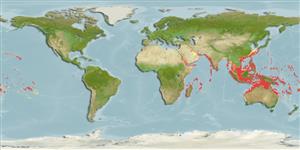Common names from other countries
>
Eupercaria/misc (Various families in series Eupercaria) >
Lutjanidae (Snappers) > Lutjaninae
Etymology: Lutjanus: Malay, ikan lutjan, name of a fish.
Environment: milieu / climate zone / depth range / distribution range
Ecología
marino; agua dulce; salobre asociado a arrecife; rango de profundidad 0 - 180 m (Ref. 37816), usually 10 - 70 m (Ref. 30573). Tropical; 31°N - 33°S, 31°E - 128°W (Ref. 55)
Indo-Pacific: East Africa to the Marquesas and Line islands, north to the Ryukyu Islands, south to Australia. More common around oceanic islands than in continental areas.
Length at first maturity / Tamaño / Peso / Age
Maturity: Lm 42.9, range 39 - ? cm
Max length : 90.0 cm TL macho / no sexado; (Ref. 9987); common length : 76.0 cm SL macho / no sexado; (Ref. 37816); peso máximo publicado: 12.5 kg (Ref. 4699); edad máxima reportada: 55 años (Ref. 72420)
Espinas dorsales (total) : 10; Radios blandos dorsales (total) : 13 - 14; Espinas anales: 3; Radios blandos anales: 8. This species is distinguished by the following characters: moderately deep body, its greatest depth 2.4-2.9 in SL; distinct groove or pit from nostrils to the front of the eye; preopercular notch and knob moderately developed; vomerine tooth patch narrow crescentic, without a medial posterior extension; gill rakers of first gill arch 6-7 + 16 = 22-23 (including rudiments). Colour of body dark reddish-brown with faint dark stripes; young and some adults with two silvery-white spots on back; pectoral fins pink with dorsal edge prominently black; juveniles sometimes have caudal end of body and the tail white. mimicking Chromis damselfishes (Ref. 9821, 90102).
Adults inhabit coral reefs, including sheltered lagoons and outer reefs (Ref. 30573). Usually found singly, often adjacent to steep outer reef slopes, but occasionally found in groups (Ref. 9710). Feeds mainly on fishes, but also take shrimps, crabs, amphipods, stomatopods, gastropods and urochordates. Large fish from oceanic areas in the western Pacific are often ciguatoxic, e.g., in Tuvalu (Ref. 9513). Caught mainly with handlines and bottom longlines (Ref. 9821). Utilized fresh and dried-salted (Ref. 9987). Juveniles mimic Chromis damselfishes (Ref. 90102). Minimum depth reported taken from Ref. 128797.
Allen, G.R., 1985. FAO Species Catalogue. Vol. 6. Snappers of the world. An annotated and illustrated catalogue of lutjanid species known to date. FAO Fish. Synop. 125(6):208 p. Rome: FAO. (Ref. 55)
IUCN Red List Status (Ref. 130435)
CITES (Ref. 128078)
Not Evaluated
Threat to humans
Reports of ciguatera poisoning (Ref. 4690)
Human uses
Can't connect to MySQL database (fbapp). Errorcode: Too many connections
